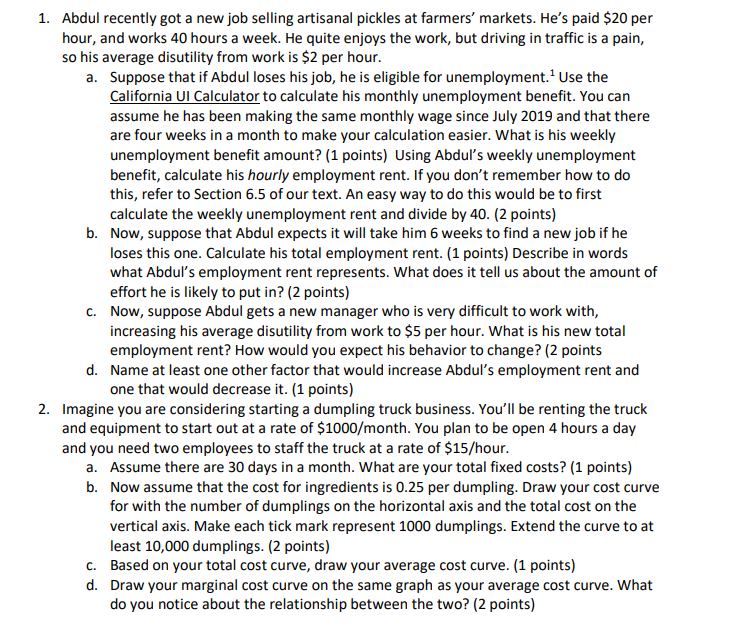1. Abdul recently got a new job selling artisanal pickles at farmers' markets. He's paid $20 per hour, and works 40 hours a week. He quite enjoys the work, but driving in traffic is a pain, so his average disutility from work is $2 per hour. a. Suppose that if Abdul loses his job, he is eligible for unemployment.' Use the California UI Calculator to calculate his monthly unemployment benefit. You can assume he has been making the same monthly wage since July 2019 and that there are four weeks in a month to make your calculation easier. What is his weekly unemployment benefit amount? (1 points) Using Abdul's weekly unemployment benefit, calculate his hourly employment rent. If you don't remember how to do this, refer to Section 6.5 of our text. An easy way to do this would be to first calculate the weekly unemployment rent and divide by 40. (2 points) b. Now, suppose that Abdul expects it will take him 6 weeks to find a new job if he loses this one. Calculate his total employment rent. (1 points) Describe in words what Abdul's employment rent represents. What does it tell us about the amount of effort he is likely to put in? (2 points) c. Now, suppose Abdul gets a new manager who is very difficult to work with, increasing his average disutility from work to $5 per hour. What is his new total employment rent? How would you expect his behavior to change? (2 points d. Name at least one other factor that would increase Abdul's employment rent and one that would decrease it. (1 points) 2. Imagine you are considering starting a dumpling truck business. You'll be renting the truck and equipment to start out at a rate of $1000/month. You plan to be open 4 hours a day and you need two employees to staff the truck at a rate of $15/hour. a. Assume there are 30 days in a month. What are your total fixed costs? (1 points) b. Now assume that the cost for ingredients is 0.25 per dumpling. Draw your cost curve for with the number of dumplings on the horizontal axis and the total cost on the vertical axis. Make each tick mark represent 1000 dumplings. Extend the curve to at least 10,000 dumplings. (2 points) c. Based on your total cost curve, draw your average cost curve. (1 points) d. Draw your marginal cost curve on the same graph as your average cost curve. What do you notice about the relationship between the two? (2 points)







